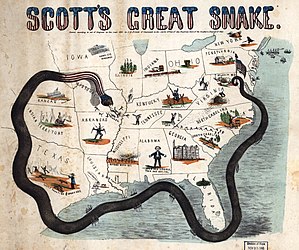
Back Théâtre du bas littoral de la guerre de Sécession French Teatro basso litoraneo della guerra di secessione americana Italian 南部沿岸戦線 (南北戦争) Japanese Zuidoostelijke kuststrook tijdens de Amerikaanse Burgeroorlog Dutch Teatro da Margem Inferior da Guerra Civil Americana Portuguese
The lower seaboard theater of the American Civil War encompassed major military and naval operations that occurred near the coastal areas of the Southeastern United States: in Alabama, Florida, Louisiana, Mississippi, South Carolina, and Texas) as well as southern part of the Mississippi River (Port Hudson and south).
Inland operations are included in the western theater or trans-Mississippi theater, depending on whether they were east or west of the Mississippi River. Coastal operations in Georgia, including the culmination of Sherman's March to the Sea, are included in the western theater.
The campaign classification established by the U.S. National Park Service,[1] which calls these the lower seaboard theater and gulf approach operations, is more fine-grained than the one used in this article. Some minor NPS campaigns have been omitted and some have been combined into larger categories. Only a few of the 31 battles the NPS classifies for this theater are described. The Port Royal Expedition of 1861 has been added, although it has not been classified by the NPS. Boxed text in the right margin show the NPS campaigns associated with each section.

Union Naval activities in this theater were dictated by the Anaconda Plan, with its emphasis on strangling the South with an ever-tightening blockade, and later in executing attacks on and occupying the port cities of New Orleans, Mobile, and Galveston. The Confederate response was mainly limited to blockade running and the Confederate Navy reacting defensively to Union incursions, with mixed success.
© MMXXIII Rich X Search. We shall prevail. All rights reserved. Rich X Search